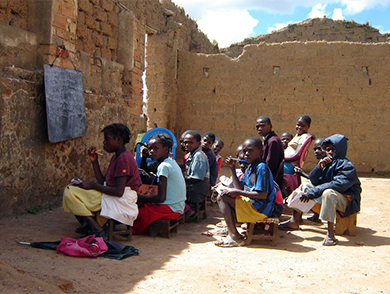| << Chapter < Page | Chapter >> Page > |
For example, the average citizen of Burundi, the lowest-income country, subsists on $150 per year (adjusted to 2005 dollars). According to data collected by the Central Intelligence Agency in its CIA Factbook, as of 2013, 90% of Burundi’s population is agrarian, with coffee and tea as the main income producing crop. Only one in two children attends school and, as shown in [link] , many are not in schools comparable to what is found in developed countries. The CIA Factbook also estimates that 15% of Burundi’s population suffers from HIV/AIDS. Political instability has made it difficult for Burundi to make significant headway toward growth, as verified by the electrification of only 2% of households and 42% of its national income coming from foreign aid.

The World Factbook website is loaded with maps, flags, and other information about countries across the globe.
Other low-income countries share similar stories. These countries have found it difficult to generate investments for themselves or to find foreign investors willing to put up the money for more than the basic needs. Foreign aid and external investment comprise significant portions of the income in these economies, but are not sufficient to allow for the capital accumulation necessary to invest in physical and human capital. But is foreign aid always a contributor to economic growth? It can be a controversial issue, as the next Clear it Up feature points out.
According to the Organization of Economic Cooperation and Development (OECD), about $134 billion per year in foreign aid flows from the high-income countries of the world to the low-income ones. Relative to the size of their populations or economies, this is not a large amount for either donors or recipients. For low-income countries, aid averages about 1.3 percent of their GDP. But even this relatively small amount has been highly controversial.
Supporters of additional foreign aid point to the extraordinary human suffering in the low-and middle-income countries of the world. They see opportunities all across Africa, Asia, and Latin America to set up health clinics and schools. They want to help with the task of building economic infrastructure: clean water, plumbing, electricity, and roads. Supporters of this aid include formal state-sponsored institutions like the United Kingdom’s Department for International Development (DFID) or independent non-governmental organizations (NGOs) like CARE International that also receive donor government funds. For example, because of an outbreak of meningitis in Ethiopia in 2010, DFID channeled significant funds to the Ethiopian Ministry of Health to train rural health care workers and also for vaccines. These monies helped the Ministry offset shortfalls in their budget.
Opponents of increased aid do not quarrel with the goal of reducing human suffering, but they suggest that foreign aid has often proved a poor tool for advancing that goal. For example, according to an article in the Attaché Journal of International Affairs , the Canadian foreign aid organization (CIDA) provided $100 million to Tanzania to grow wheat. The project did produce wheat, but nomadic pastoralists and other villagers who had lived on the land were driven off 100,000 acres of land to make way for the project. The damage in terms of human rights and lost livelihoods was significant. Villagers were beaten and killed because some refused to leave the land. At times, the unintended collateral damage from foreign aid can be significant.
William Easterly, professor of economics at New York University and author of The White Man’s Burden , argues that aid is often given for political reasons and ends up doing more harm than good. If the government of a country creates a reasonably stable and market-oriented macroeconomic climate, then foreign investors will be likely to provide funds for many profitable activities. For example, according to The New York Times , Facebook is partnering with multiple organizations in a project called Internet.org to provide access in remote and low-income areas of the world, and Google began its own initiative called Project Loon. Facebook’s first forays into providing Internet access via mobile phones began in stable, market-oriented countries like India, Brazil, Indonesia, Turkey, and the Philippines.
Policymakers are now wiser about the limitations of foreign aid than they were a few decades ago. In targeted and specific cases, especially if foreign aid is channeled to long-term investment projects, foreign aid can have a modest role to play in reducing the extreme levels of deprivation experienced by hundreds of millions of people around the world.

Notification Switch
Would you like to follow the 'Principles of macroeconomics for ap® courses' conversation and receive update notifications?